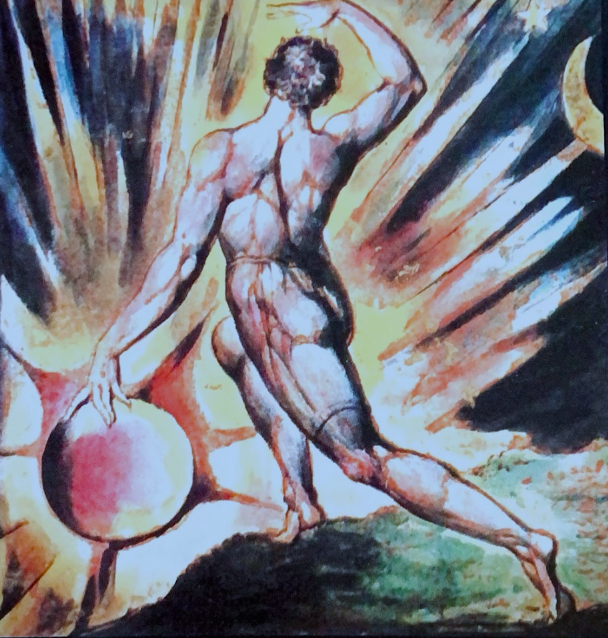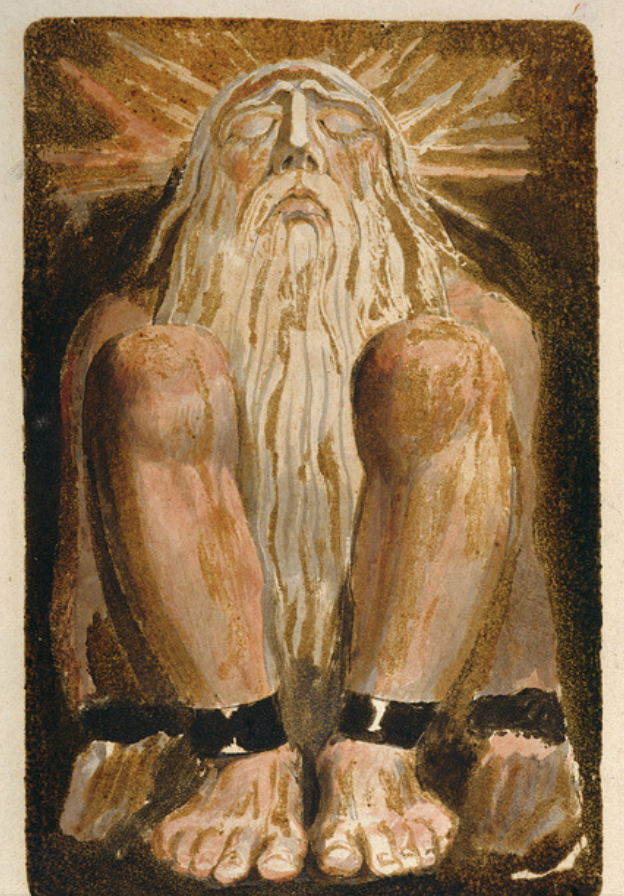William Blake and Cosmic Basketball?
A book review of John Higgs’ William Blake vs. the World

One might not expect a book on William Blake to include a discussion of surfers, athletes, musicians, dancers and others excelling in a selfless and self-transforming cosmic experience sometimes called the “zone.” It is a time when mastered technique often blends creatively in conquering challenges with grace, beauty, and elegance. It is a time when a loss of self-consciousness accompanies a wondrous sense of being connected to a powerful source.
It can happen for skilled amateurs. It sometimes is especially strong in team sports where players sometimes somehow anticipate the right moves of each other in a cosmic dance.
Basketball fans recently saw, at the sport’s highest level, an extraordinary example of the flow zone led by the one the Washington Post headlined as “celestial,” Steph Curry.
In British cultural commentator John Higgs’ William Blake vs. the World we find:
High-functioning athletes and highly skilled musicians sometimes talk about becoming so focused that they lose all sense of time, space and ego. They become so fully submerged in what they are doing that it is as if they do not exist, except in their actions. That state is called “flow” by psychologists and more casually “being in the zone.”
This reviewer was blessed to experience this many times as a middle aged basketball player whose life was transformed in my late thirties from a sedentary one to one which earned himself the nickname of “Silky” in playground ball on the flatlands of Oakland.
I have also had the vicarious joy of following the hoop career since high school of an honor student of mine, Damian Lillard, perennial NBA All Star, whose timely scoring is known as “Dame Time.” When he chose his uniform number “0” he chose it to honor the three venues of his hoop career: Oakland, Ogden and Oregon. Soon he would frequently enter his own 0-zone, best demonstrated by two playoff series winning shots:
While Damian seems to dominate clutch buzzer beaters, another NBA star, Steph Curry, recently dominated league finals with his “celestial” game.
Curry helped change the game frustrating youth coaches forever—by often frequently making impossible shots and inspired passes. His own zone is often described in heavenly terms that appear to go beyond the stellar that all stars are used to. I checked out some thesauri and found the perfect term: ineffable. It refers to a form of cosmic holiness which is beyond words. The ineffable Steph is inevitable.
NY Times Article “The Artistry of Stephen Curry“.
Skiers, athletes in many sports, dancers and musicians often pursue their passion by seeking to become part of the Flow. I was blessed to often hear my late musician wife perform in a “flow zone” with jazz artists. Fine examples of improvised brilliance can be found in the stunning interplay between jazz clarinet virtuoso Clarence Warren and a choir directed from the piano by my late wife, Alice Wildermuth O’Sullivan:
What might this have anything to do with William Blake? British author John Higgs makes all sorts of remarkable Blake-throughs with life today, in his book newly published in the USA.
For a very unusual and sometimes deeply troubled person who died in obscurity and poverty almost two hundred years ago, William Blake has extraordinary influence today, especially in his home city of London and the British isle he knew as Albion.
He is a major figure as a visual artist/printmaker as well as poet/ prophet/thinker whose message, deeply rooted in his unique version of a kind of proto-progressive/bardic Christianity, is how the divine exists in the human imagination and can inform our minds and actions, relate eternity to the “vegetative” present, and rebalance vision distorted by “Newton’s sleep,” an overemphasis of the logical, prosaic verbal, rational, mathematical and scientific.
The most recent addition, honored on his 200th birthdate, to the Poets’ Corner in Westminster Abbey, he “haunts” modern culture by deeply influencing generations of poets, thinkers, musicians and artists in often unusual ways, ranging from bardic Blake-throughs with Rossetti, Yeats and Ginsburg, to inspiring creatives of many sorts—as well as creators of horror films and video games.
This is all the result of the enormous productivity of someone who struggled all his adult life to survive financially, supporting himself and wife/artistic partner Katherine mainly as a “for hire” engraver.
He also struggled with the perception of being “mad,” illustrated perhaps- all-too-well by psychologically probing bizarre images and frequent talk about visions and conversations from the ages.
His accidentally being caught in an angry riotous mob and being tried for sedition suggest how paranoids some- times have real enemies.
Why and how has he deeply influenced this largely secular century? I highly suggest you read (or listen to) British cultural critic John Higgs’ William Blake vs. the World, recently published in the U.S.A. after a spectacular 2021 book launch at the British Library.
Higgs is a wide ranging and adventurous intellectual explorer and man of letters, noted for his interest in almost anything, including historical and futuristic trends and figures, such as Timothy Leary, Aldous Huxley and Robert Anton Wilson. While writing a coherent and historically accurate presentation on his subject and his struggles, he manages to lead readers in explorations on “madness,” mental illness and healing, imagination, class struggles, reli- gious, political, philosophical and pedagogic history, contraries, injustice and even quantum physics. This helps us understand the power of a most singular man who has influenced many through the power of words, images and a strangely compelling message of expanding our perception so as to rebalance our minds to include the divine.
Higgs skillfully presents life details that include sexual disappointment and incidents of Blake being caught up in a rioting mob and being tried for sedition. He was also upset, while struggling to survive financially, that he was frequently dismissed as “mad”, but he knew that was related to his frequently telling of visions and conversations with Milton, Shakespeare, Dante, Michelangelo, the angel Gabriel, Jesus, Blake’s brother, Robert and a distinguished cadre of folk from the ages who possessed Poetic Genius.
Higgs’ book presents his subject effectively by stressing matters very important-but-not-well-known:
• Blake was home-schooled except for training in art, engraving and printing.
• He created a total art where all the steps of publishing (writing, editing, illustrating, engraving, coloring and printing) were in his hands with his poems having his own, never transcribed, music as well. Unfortunately, the next step of marketing effectively avoided him, with none of his poems, sold inexpensively, selling more than thirty copies.
• He despised the “ignorant hirelings” of moneyed Oxford/Cambridge products who were trained unimaginatively in a classics-dominant version of “Newton’s sleep.” His writing, in style and message, emphasized he was from common folk.
• Much of his religious thinking was shaped by the English versions of “antinomian” (anti-law) sects which were part of the often forgotten “left wing” of the Protestant Reformation which took many forms in England a hundred years before Blake’s life. He clearly saw himself as Christian, but did not identify with any tradition other than a short exposure to the church of Swedish proto-scientist-turned- mystic Emmanuel Swedenborg, whose writings provoked Blake to write “The Marriage of Heaven and Hell” in response.
• Unlike many in his time, he opposed slavery, the exploitation of children and animals, colonialism, war, sexual trafficking and the monarchy. His circle of acquaintances included Thomas Paine, Mary Wollstonecraft, Joseph Priestly, Henri Fuseli and the radical publisher Joseph Johnson.
• He had special scorn for the established Church of England, mocking in poetry how an annual Maundy Thursday service for poor children in St. Paul’s Cathedral was somehow fulfilling its responsibility toward them.
• No one would characterize his religious views as orthodox, especially on the Trinity (whose first person he sometimes called “Nobodaddy”), but he strongly honored Jesus and valued the importance of forgiveness and reconciliation.
• Although modern biblical scholarship was just emerging in his day, many of his views presage Progressive Christianity.
• Mental health issues, which could be post-diagnosed as forms of schizophrenia and depression, that Blake had were related to struggling to survive financially, living at a politically fraught time, wishing for a more adventurous sex life, dealing with the madness issue and coping with his sedition trial which could have resulted in the death penalty. Higgs saw self-healing in his art and writing, even when strangely attacking perceived enemies in his prophetic works.
• At the heart of Blake’s message was an understanding that the divine exists in the human imagination. This is presented in often obscure longer mythological/prophetic works in which the poet maintains that the highly rational demigod-like Urizen should be augmented in the mind with three other Zoas, creatures out of Ezekiel which represent physical, spiritual and psychological forces essential to a balanced mind and life.
Higgs perceptively relates Blake’s reordering of the mind to modern neurological study of the bicameral brain, with Urizen/Newton representing the left hemisphere (rational, logical, prosaic verbal, mathematical) while his other “Zoas,” mythologically presented, represent the right (visual, physical, creative, emotional).
This writer, a left-hander, prefers to call these contrasting hemispheres as “deft” and “light.” http://audio.holdenvillage.org/node/12547
Higgs acknowledges that a too simplistic understanding of this dichotomy emerged when first popularized, but that it is largely accurate and most helpful to understand how the frequent dominance of left-brain interests seriously unbalances the mind and human cultures. He recalls dramatic changes in the lives of Swedenborg, Voltaire, Tolle, Sartre and modern stroke and war/accident victims to illustrate how balancing changes in mind and vision can happen at different speeds, sometimes slowly using short-term exercises popularized by the Mindfulness movement.
Higgs’ choice of title for his magisterial work, William Blake vs. the World,
is inspired because Blake accepted his lack of material success in view of his seeing himself in a company of Poetic Geniuses from the ages. When he died, few were even aware of his multifaceted and artistic counter-cultural struggles with the world in his day. Higgs’ book is a celebration of how much better he is doing today.
Isn’t it amazing how a golden string from antiquity to Milton to Blake has influenced artists and poets ever since? We are challenged to free ourselves from “mind-forged manacles” and enter a paradisal flow zone cosmically full of dance and song. It goes far beyond Newton’s sleep.
Check O’Sullivan’s Blake-inspired “un-official international anthem”.
To hear a radio interview podcast of O’Sullivan on Blake:




